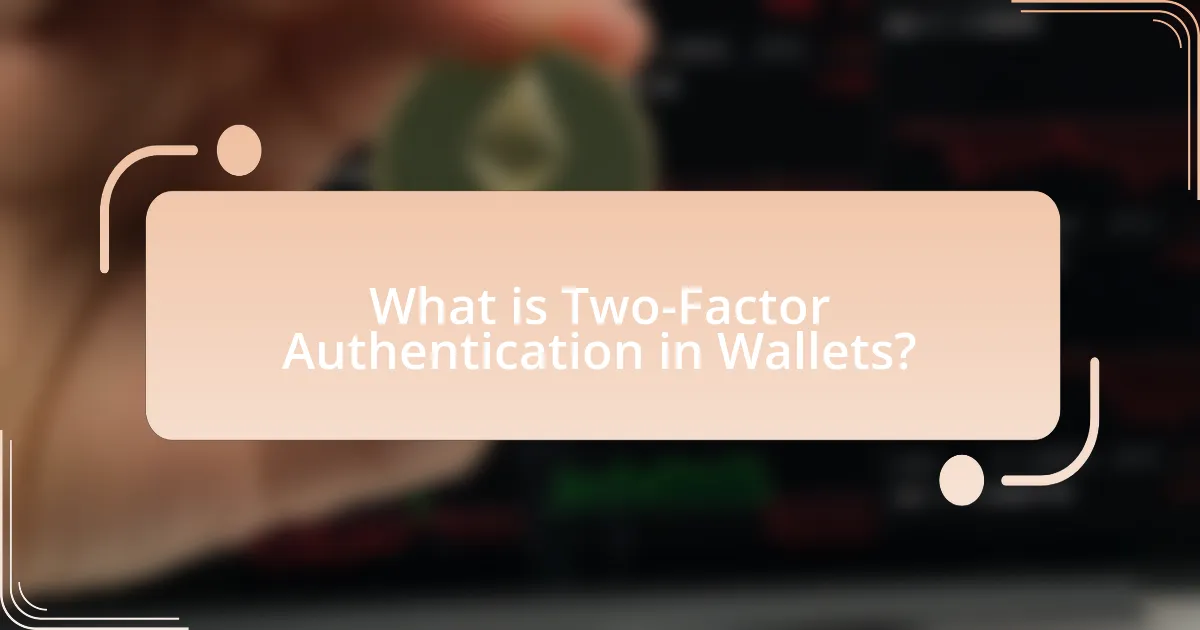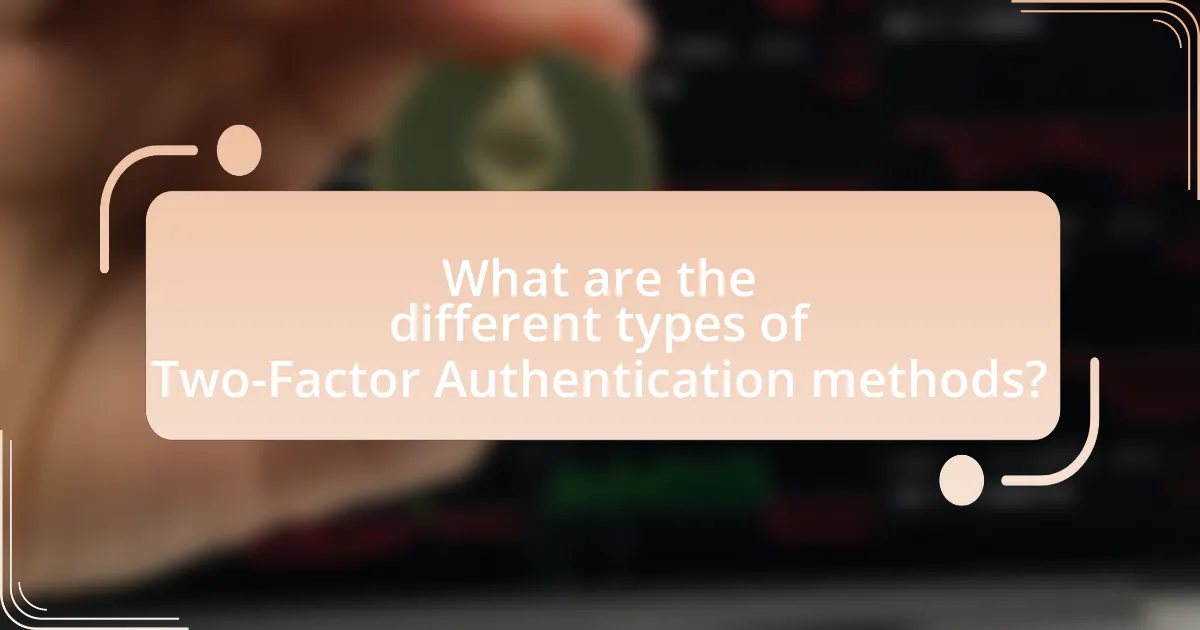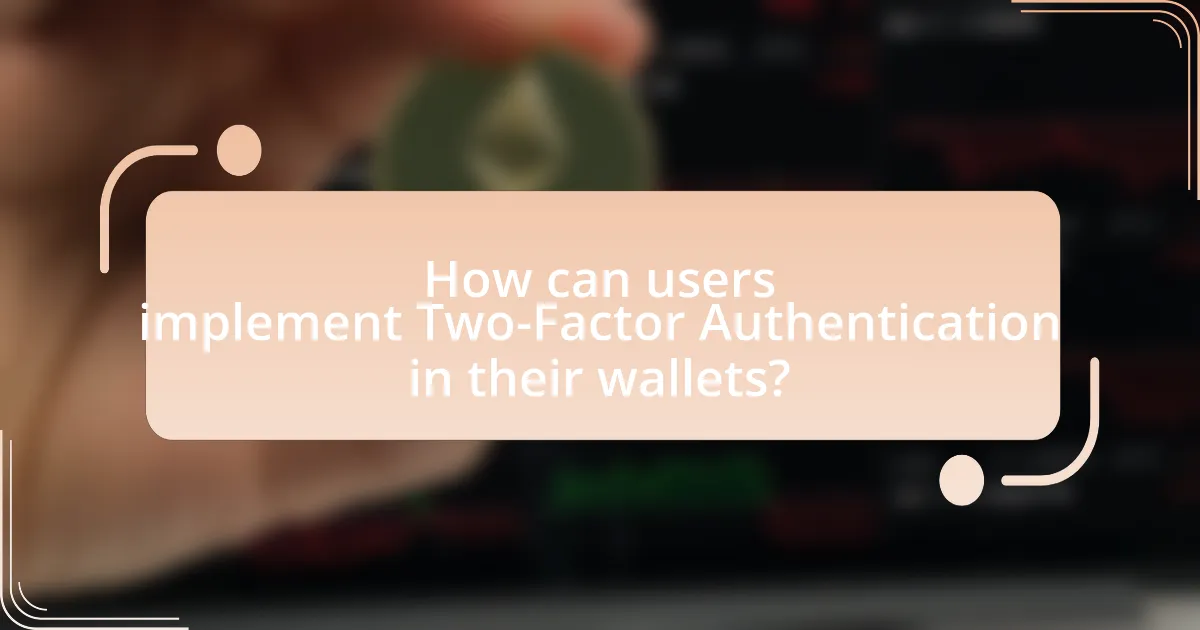Two-Factor Authentication (2FA) is a critical security measure for digital wallets, requiring users to provide two forms of verification—something they know, like a password, and something they possess, such as a mobile device. This dual-layer approach significantly enhances wallet security by reducing the risk of unauthorized access and protecting sensitive financial information. The article explores how 2FA works, its key components, various methods of implementation, and the importance of adopting this security measure to mitigate risks associated with digital wallets. Additionally, it addresses common challenges users may face and offers best practices for effective 2FA setup and maintenance.

What is Two-Factor Authentication in Wallets?
Two-Factor Authentication (2FA) in wallets is a security measure that requires two forms of verification before granting access to a digital wallet. This typically involves something the user knows, such as a password, and something the user possesses, like a mobile device that receives a one-time code. The implementation of 2FA significantly reduces the risk of unauthorized access, as it adds an additional layer of security beyond just a password. According to a study by Google, accounts with 2FA are 100% more secure against phishing attacks, demonstrating its effectiveness in protecting sensitive financial information stored in digital wallets.
How does Two-Factor Authentication enhance wallet security?
Two-Factor Authentication (2FA) enhances wallet security by requiring two forms of verification before granting access, significantly reducing the risk of unauthorized access. This method combines something the user knows, such as a password, with something the user has, like a mobile device for receiving a one-time code. According to a study by Google, 2FA can block 100% of automated bots and 96% of phishing attacks, demonstrating its effectiveness in protecting sensitive information. By implementing 2FA, wallets become more resilient against hacking attempts, as attackers would need both verification factors to gain access.
What are the key components of Two-Factor Authentication?
The key components of Two-Factor Authentication (2FA) are something you possess and something you know. The first component, something you possess, typically refers to a physical device such as a smartphone or hardware token that generates a one-time code. The second component, something you know, usually involves a password or PIN that the user must enter. This dual-layer approach significantly enhances security by requiring both elements for access, making unauthorized entry more difficult. According to the Cybersecurity & Infrastructure Security Agency, implementing 2FA can reduce the risk of account compromise by up to 99.9%.
How do these components work together to protect wallets?
Two-factor authentication (2FA) components work together to enhance wallet security by requiring two distinct forms of verification before granting access. The first component typically involves something the user knows, such as a password or PIN, while the second component is something the user possesses, like a mobile device or hardware token that generates a time-sensitive code. This dual-layer approach significantly reduces the risk of unauthorized access, as an attacker would need both the password and the physical device to compromise the wallet.
Research indicates that accounts secured with 2FA are 99.9% less likely to be compromised, highlighting the effectiveness of this security measure in protecting digital wallets.
Why is Two-Factor Authentication essential for digital wallets?
Two-Factor Authentication (2FA) is essential for digital wallets because it significantly enhances security by requiring two forms of verification before granting access. This dual-layered approach mitigates the risk of unauthorized access, as even if a password is compromised, the second factor—such as a text message code or authentication app—remains a barrier. According to a study by Google, implementing 2FA can block up to 99.9% of automated attacks, demonstrating its effectiveness in protecting sensitive financial information stored in digital wallets.
What risks do digital wallets face without Two-Factor Authentication?
Digital wallets without Two-Factor Authentication (2FA) face significant risks, primarily including unauthorized access and financial theft. The absence of 2FA means that a single compromised password can grant attackers full access to the wallet, leading to potential loss of funds. According to a report by the Federal Trade Commission, identity theft cases have surged, with many incidents linked to inadequate security measures like the lack of 2FA. Furthermore, a study by the Cybersecurity & Infrastructure Security Agency indicates that accounts secured with 2FA are 99.9% less likely to be compromised. Thus, without 2FA, digital wallets are highly vulnerable to cyberattacks and fraud.
How does Two-Factor Authentication mitigate these risks?
Two-Factor Authentication (2FA) mitigates risks by adding an additional layer of security beyond just a password. This process requires users to provide two forms of identification before accessing their accounts, typically something they know (a password) and something they have (a mobile device or hardware token). According to a study by Google, 2FA can block 100% of automated bots, 99% of phishing attacks, and 90% of targeted attacks, significantly reducing the likelihood of unauthorized access to wallets. By requiring this second factor, even if a password is compromised, the account remains secure as the attacker would still need the second form of verification to gain access.

What are the different types of Two-Factor Authentication methods?
The different types of Two-Factor Authentication (2FA) methods include SMS-based authentication, email-based authentication, authenticator apps, hardware tokens, and biometric verification. SMS-based authentication sends a one-time code to the user’s mobile device, while email-based authentication sends a code to the user’s registered email address. Authenticator apps, such as Google Authenticator or Authy, generate time-based codes that users enter during login. Hardware tokens are physical devices that generate codes or connect to a computer for authentication. Biometric verification uses unique physical characteristics, such as fingerprints or facial recognition, to confirm identity. Each method enhances security by requiring a second form of verification beyond just a password.
How do SMS-based and app-based authentication compare?
SMS-based authentication is generally less secure than app-based authentication. SMS messages can be intercepted through various methods, such as SIM swapping or man-in-the-middle attacks, making them vulnerable to unauthorized access. In contrast, app-based authentication, which typically uses time-based one-time passwords (TOTPs) generated by an authentication app, operates offline and is less susceptible to interception. Research indicates that app-based methods significantly reduce the risk of phishing attacks, as they require physical access to the device where the app is installed. Therefore, while both methods provide an additional layer of security, app-based authentication is considered more robust due to its resistance to common attack vectors associated with SMS.
What are the advantages and disadvantages of SMS-based authentication?
SMS-based authentication offers advantages such as convenience and widespread accessibility, allowing users to receive one-time codes on their mobile devices quickly. This method is easy to implement for both users and service providers, as it requires minimal technical infrastructure. However, disadvantages include vulnerability to interception through techniques like SIM swapping and phishing attacks, which can compromise security. Additionally, reliance on mobile networks means that users may face issues in areas with poor reception or during network outages, potentially hindering access to their accounts.
What makes app-based authentication more secure?
App-based authentication is more secure due to its use of time-sensitive one-time passwords (OTPs) and the requirement for a second factor, typically a mobile device, which is less susceptible to phishing attacks. This method enhances security by ensuring that even if a password is compromised, unauthorized access is prevented without the second factor. Research indicates that two-factor authentication can block up to 99.9% of automated attacks, demonstrating its effectiveness in safeguarding sensitive information.
What role do biometric methods play in Two-Factor Authentication?
Biometric methods serve as a critical component in Two-Factor Authentication (2FA) by providing a unique and secure means of verifying a user’s identity. These methods, which include fingerprint scanning, facial recognition, and iris scanning, enhance security by requiring something the user is, in addition to something the user knows, such as a password. The integration of biometrics into 2FA significantly reduces the risk of unauthorized access, as biometric traits are difficult to replicate or steal compared to traditional authentication factors. For instance, a study by the National Institute of Standards and Technology (NIST) found that biometric authentication can improve security by reducing the likelihood of account compromise, as it adds a layer of protection that is inherently tied to the individual user.
How do fingerprint and facial recognition enhance security?
Fingerprint and facial recognition enhance security by providing unique biometric identifiers that are difficult to replicate or forge. These technologies ensure that only authorized users can access sensitive information or perform transactions, significantly reducing the risk of unauthorized access. For instance, a study by the National Institute of Standards and Technology (NIST) found that biometric systems can achieve accuracy rates exceeding 99%, making them highly reliable for identity verification. Additionally, the integration of these biometric methods in two-factor authentication systems adds an extra layer of security, as they require something the user has (like a device) and something the user is (biometric data), thereby strengthening overall security measures in digital wallets.
What are the limitations of biometric authentication?
Biometric authentication has several limitations, including vulnerability to spoofing, privacy concerns, and the potential for irreversible loss of access. Spoofing occurs when an individual uses fake biometric traits, such as silicone fingerprints or high-resolution facial images, to bypass security measures. Privacy concerns arise from the collection and storage of sensitive biometric data, which can be misused or hacked, leading to identity theft. Additionally, if a biometric trait is compromised, such as a fingerprint, it cannot be changed like a password, resulting in permanent loss of access to secured systems. These limitations highlight the need for complementary security measures, such as two-factor authentication, to enhance overall security.

How can users implement Two-Factor Authentication in their wallets?
Users can implement Two-Factor Authentication (2FA) in their wallets by enabling the feature in the wallet’s security settings. Most digital wallets provide an option to activate 2FA, which typically involves linking a mobile authentication app, such as Google Authenticator or Authy, to the wallet account. Once activated, users will receive a time-sensitive code on their mobile device that must be entered alongside their password during the login process. This additional layer of security significantly reduces the risk of unauthorized access, as it requires both something the user knows (password) and something the user has (authentication code).
What steps should users take to enable Two-Factor Authentication?
To enable Two-Factor Authentication (2FA), users should first access their account settings on the platform they are using. Next, they need to locate the security settings section, where they will find the option to enable 2FA. After selecting this option, users typically must choose a method for receiving the second factor, such as a text message, authentication app, or email. Finally, users should follow the prompts to verify their chosen method, which often includes entering a code sent to their device. This process enhances account security by requiring both a password and a second form of verification.
What common mistakes should users avoid during setup?
Users should avoid using weak passwords during setup, as this significantly increases the risk of unauthorized access. Weak passwords often lack complexity and can be easily guessed or cracked using common techniques. Additionally, users should not skip enabling two-factor authentication (2FA), which adds an essential layer of security by requiring a second form of verification. Failing to back up recovery codes or keys is another critical mistake, as losing access to these can result in permanent loss of wallet access. Lastly, users should avoid ignoring software updates, as these often contain important security patches that protect against vulnerabilities.
How can users test the effectiveness of their Two-Factor Authentication?
Users can test the effectiveness of their Two-Factor Authentication (2FA) by attempting to log into their accounts using only their password, without the second factor. This method reveals whether the 2FA is functioning correctly, as access should be denied without the second authentication step. For instance, if a user can still gain access to their account solely with the password, it indicates a failure in the 2FA implementation. Additionally, users can review their account security settings to ensure that 2FA is enabled and functioning as intended, which is supported by security best practices that emphasize the necessity of 2FA for protecting sensitive information.
What best practices should users follow for Two-Factor Authentication?
Users should enable Two-Factor Authentication (2FA) on all accounts that support it to enhance security. This practice significantly reduces the risk of unauthorized access, as it requires not only a password but also a second form of verification, such as a text message code or authentication app notification. According to a study by Google, 2FA can block 100% of automated bots and 96% of phishing attacks, demonstrating its effectiveness in protecting sensitive information. Additionally, users should choose authentication methods that are less susceptible to interception, such as using an authenticator app instead of SMS, and regularly update their recovery options to ensure they can regain access if needed.
How can users ensure their recovery options are secure?
Users can ensure their recovery options are secure by enabling two-factor authentication (2FA) on their accounts. This additional layer of security requires not only a password but also a second form of verification, such as a code sent to a mobile device or an authentication app. According to a study by Google, 2FA can block 100% of automated bots and 96% of phishing attacks, significantly enhancing account security. By using unique and complex passwords in conjunction with 2FA, users can further protect their recovery options from unauthorized access.
What should users do if they lose access to their Two-Factor Authentication method?
Users should immediately utilize any backup codes provided during the Two-Factor Authentication setup to regain access. If backup codes are unavailable, users must follow the account recovery process outlined by the service provider, which often includes verifying identity through email or phone number. Many platforms also offer support channels to assist users in regaining access, emphasizing the importance of keeping recovery options updated.
What are the common challenges faced with Two-Factor Authentication?
Common challenges faced with Two-Factor Authentication (2FA) include user resistance, potential for phishing attacks, and issues with recovery processes. User resistance arises because individuals often find 2FA inconvenient, leading to lower adoption rates. Phishing attacks can compromise the second factor, especially if users are tricked into providing their authentication codes. Additionally, recovery processes can be cumbersome; if users lose access to their second factor, regaining account access can be difficult, which may discourage users from enabling 2FA in the first place. These challenges highlight the need for improved user education and more user-friendly recovery options to enhance the effectiveness of 2FA.
How can users overcome issues related to device compatibility?
Users can overcome issues related to device compatibility by ensuring that their wallets support multiple platforms and operating systems. This can be achieved by selecting wallets that are designed to be cross-compatible, such as those that offer web, mobile, and desktop versions. Additionally, users should regularly update their devices and wallet applications to the latest versions, as updates often include compatibility improvements. Research indicates that wallets with robust support for various devices can enhance user experience and security, as seen in studies highlighting the importance of adaptability in digital finance tools.
What should users do if they encounter authentication failures?
Users encountering authentication failures should first verify their login credentials for accuracy. This includes checking for typos in usernames or passwords and ensuring that the correct account is being accessed. If the credentials are correct, users should then check their two-factor authentication method, ensuring that the device or application used for the second factor is functioning properly. In cases where the issue persists, users should utilize the account recovery options provided by the service, such as password reset links or security questions. According to a study by the National Institute of Standards and Technology, implementing two-factor authentication significantly reduces the risk of unauthorized access, highlighting the importance of resolving authentication issues promptly to maintain account security.